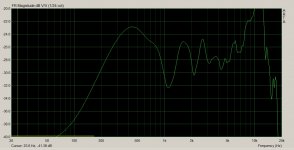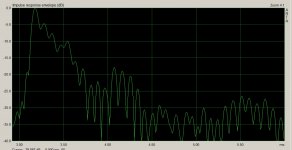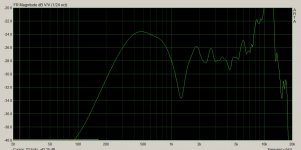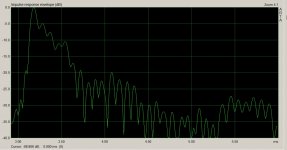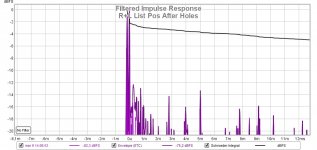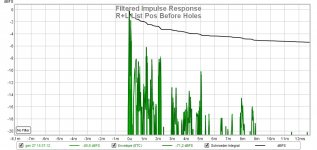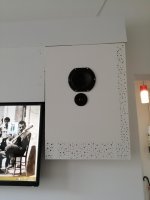IR
Please, tell me what that chart can tell.
the second peak delayed by 2ms would equate to .68m difference in sound traveling to the microphone. Was that measurement before you made your holes or after?
To enhance diffraction at the box edges, I cut a circular panel, the driver in the center.
The radius of the panel is 28cm
The mic is on axis, at 70cm from the driver.
The additional distance for the diffracted wave is 33cm in length, 1ms in time.
Did I wrong something with Pythagoras?
No, I also would not expect quite a such strong signal from edge diffraction. Would any close reflective surface give you that time delay? You could also vary the microphone distance. I make mostly of my measurements at 30cm distance if I want to measure the driver in a room so reflections of wall/floor will be of relative lower level.
free space (outdoors) would be better for what you want to investigate with your measurements
free space (outdoors) would be better for what you want to investigate with your measurements
Yes both in frequency and impulse at 1ms. My speakers have a circular front baffle of 70cm diameter but the drivers are arranged quite eccentric with only10cm space to edge so the distance from drivers to edge varies and I see +/- no comb filtering in the frequency spectrum or no significant peak in the impulse response I can contribute to edge diffraction. There are micro perforated panels used for sound absorbers and they have a quite large absorption spectrum compared to other absorbers but I do not know if they work efficiently if the sound is traveling parallel to the surface. Would be interesting to try but difficult to get (and expensive).
Last edited:
I'll use perforated instead rounded edge here:
A-tricky-sonorization.html
Using holes 2-3-5-8 mm.
Interested in microperforation.
A-tricky-sonorization.html
Using holes 2-3-5-8 mm.
Interested in microperforation.
The wiki for Micro perforated plate
I do not have access to Potential of microperforated panel absorber by Dah-You Maa
Maybe this is usefull: Hybrid sound absorbers combining micro-perforated panels with conventional absorption mechanisms
I do not have access to Potential of microperforated panel absorber by Dah-You Maa
Maybe this is usefull: Hybrid sound absorbers combining micro-perforated panels with conventional absorption mechanisms
I have a small sample of SoundPly Acoustic Panels | Acoustically, Structurally & Visually Superior. but there should be more sources in Europe. There was even a translucent plastic foil acting as a micro perforated absorber available.
Grazie, I do not find it around, only in brochure. It seems to me that here it is considered archistar stuff.
I found an online simulator, but I do not understand the principle, and it seems too optimistic.
Predicting the absorption coefficient of micro-perforated plates | Kai's thoughts
I found an online simulator, but I do not understand the principle, and it seems too optimistic.
Predicting the absorption coefficient of micro-perforated plates | Kai's thoughts
thanks for that link. The reason I find it interesting that it is a fairly wide band low frequency absorber (relative to a classical Helmholz) by itself but combined with a standard absorber (as an additional layer) which does not work well in that frequencies it allows wider band absorption.
I still don't know how it would work at low incidence angle as in your idea.
I still don't know how it would work at low incidence angle as in your idea.
Regarding the listening, I have the typical endorphins levels of a diyer that judges his artifact.
Regarding the measurements:
two months separate the graphs,
I have no experience in acoustic measurements,
I do not have professional equipment,
... and I'm a diyer who measures his artifact.
However,
the physical bases of functioning exist, even if the proposed models do not consider "holes on the edge",
it is easy for everydiyer to try,
in tiny rooms, a lot of good commercial speakers lean against the wall, too high, with tremendous exits.
IMO

Regarding the measurements:
two months separate the graphs,
I have no experience in acoustic measurements,
I do not have professional equipment,
... and I'm a diyer who measures his artifact.
However,
the physical bases of functioning exist, even if the proposed models do not consider "holes on the edge",
it is easy for everydiyer to try,
in tiny rooms, a lot of good commercial speakers lean against the wall, too high, with tremendous exits.
IMO
- Status
- This old topic is closed. If you want to reopen this topic, contact a moderator using the "Report Post" button.
- Home
- General Interest
- Room Acoustics & Mods
- An attempt to diffuse really close to the source
